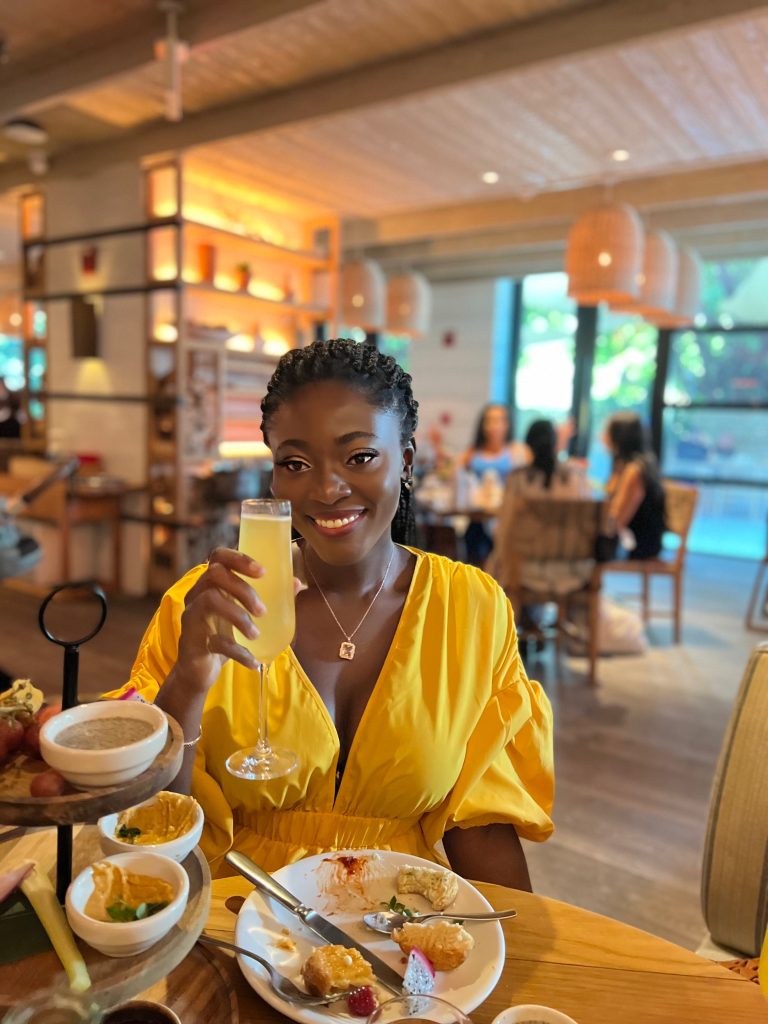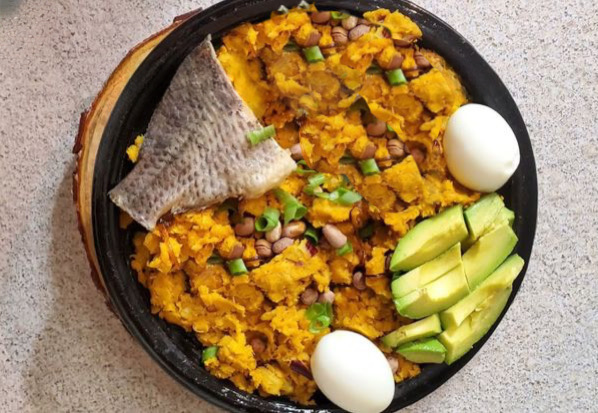
Fiona Adjei Boateng is a Ghanaian food-enthusiast, who enjoys all things food. She’s currently pursuing a doctoral degree in Social Psychology where she studies organizational behaviors and leadership and how different identities, like gender, race, age, etc., affect who is seen as capable of being a leader in different contexts. She’s also a graduate adjunct instructor at NYU teaching Social and Personality Psychology. Outside of school, Fiona loves cooking and exploring new restaurants and cuisines.
Can you give a brief intro?
My name is Fiona Adjei Boateng from Ghana. I’m currently a PhD student at NYU studying Social Psychology and I live in New York.
On a scale of 1-10 on our foodie scale, where 1 is ‘I only eat for sustenance’ and 10 is ‘I enjoy all things food’ where would you place yourself?
Oh! I’m a big old 10. I eat food because I enjoy it, and I cook food for myself and for the people around me because I enjoy it. For me, it goes way beyond cooking or eating only for sustenance – it’s more of a hobby when I’m cooking and organizing meals; even if I could replace food with nutritional supplements so I wouldn’t need food anymore, I’d still want to be around food in some capacity.
Let’s dive into Ghanaian cuisine. How would you describe Ghanaian food?
Overall, it is very diverse. We have so many interpretations of what constitutes typical Ghanaian food based on where you are in Ghana, but one thing that I would say runs through all the different versions of typical food is that Ghanaian foods tend to be spicy – we don’t play with seasonings and spices, and they also tend to be carbohydrate-heavy. The main meal is always going to be made up of some kind of carbohydrate-heavy dish like rice, cassava, plantain, millet, corn, or something related to that. And there’s normally going to be some kind of meat – Ghanaians love meat! We organize so much of our traditional foods around what kind of meat we’re using in the preparation. It’s also a big part of how we even celebrate important things in Ghana. As a matter of fact, I personally haven’t come across many Ghanaian vegetarians or vegans, although I would love to meet more of them because I think there’d be so much to learn from their diet in the Ghanaian context! We also tend to incorporate the vegetables and the extra stuff into the food preparation, so veggies are rarely a meal on their own although we definitely use a lot of it, as part of our soups and stews or even as garnish. In conclusion, Ghanaian food is generally very balanced: we always have the meats and veggies accompanying the main carbohydrate dish – all nicely spiced and flavorful.
You mentioned that Ghanaians love meat in their foods. Is there a particular type of meat they love eating?
There is actually no one type of meat that Ghanaians prefer over the others in general. Chicken is very common and easily accessible so more people might use that, but we use all types of meat in our cuisine. Of course, there are some particular foods or occasions that require that we use certain types of meats, and there are even some foods that are just as good without any meats, so it can be up to the discretion of the person or the occasion, but you can always expect meat at Ghanaian events.
So, if you were going to use food to convince someone to become a Ghanaian, what dish would you recommend to that person?
For me, I would introduce this person to two dishes. The first one would be Waakye because it’s my all-time favorite, and I strongly believe it is underrated. Personally, I would choose waakye over jollof any day, although people are more familiar with jollof. If I were to trying to convince someone to become Ghanaian, I’d probably do it with waakye, and not just the waakye rice and beans, but it has to be authentic waakye with all the different parts: the rice and beans with the tomato stew, the shito sauce (Ghanaian pepper sauce made with cayenne pepper powder, fish and shrimp powder, onions, ginger and other spices), the gari, the spaghetti, the hard-boiled egg, the salad, the avocado and of course some fish or whatever meat you prefer. All that together makes the waakye complete. The second dish for me would be Etor. This is partially ripe plantain mashed with pepper and onions, mixed with palm oil and salt. It’s normally eaten with salted fish, groundnuts, avocado and of course hard-boiled eggs. This dish isn’t as popular outside of Ghana relative to other Ghanaian foods, but it’s definitely up there in terms of uniqueness, simplicity, and just amazing taste. It’s one of those dishes that you make for someone to communicate just how dear that person is to you – at least that’s how it was in my home, so I always associate it with that feeling of warmth and acceptance.

Let’s go back to your first dish, waakye, for a minute. You mentioned that it has to be authentic – how exactly does one spot an authentic waakye dish? First of all, people try to do too much with waakye these days, but it’s really easy to keep it simple and authentic. Quality waakye should always have that rich deep red color that comes from cooking the waakye rice and bean with sorghum leaves. The rice and beans shouldn’t be too hard or nicely separated after cooking – that’s a red flag! The best waakye is normally with rice and beans that is cooked to be softer than the rice for jollof, the kind of rice that sticks to the ladle when being served. The gari shouldn’t be served dry, but should be softened with some water, or even better with some oil from the tomato stew to give it the color and extra flavor. Of course, it should have some good spicy shito – not mild, spicy – along with the tomato stew (the tomato stew isn’t a replacement for the shito!). Even better if it has the spaghetti, salad, and avocado on the side, and for a treat, look for a place with the hard-boiled egg that is fried after being boiled – chef’s kiss!
What is your go-to Ghanaian dish to prepare and your favorite Ghanaian meal?
My go-to Ghanaian dish is jollof because it’s less time-consuming to prepare but if I were to actually dedicate time to cook a Ghanaian dish, it would be waakye because it’s my favorite. I could also make some soup dishes like rice balls and groundnut soup, as my go-to when I have all the ingredients and I’m feeling for something different.

Tell us about Ghanaian soup dishes We have so many of them, I couldn’t possibly go over all of them.
We have different kinds of soups similar to the Nigerian pepper soups, which I think we call light soups. I think that our soup dishes are generally distinguished by the type of meat that is being used. For instance, light soup with chicken would be chicken light soup and its preparation will be only slightly different from goat light soup. Then we have the heavier soups which start as similar to light soups, and then we add on the extras. For instance, we have abenkwan (palm nut soup) which soup with palm nut puree incorporated, nkatenkwan (groundnut soup) which is soup with groundnut paste incorporated, abunuabunu (green soup) which has cocoyam leaves incorporated, and so on and so forth. We also have a lot of great stews like okra stew, eggplant stew, spinach stew, egg stew. These soups and stews aren’t as common outside of Ghana as our rice dishes, but they’re staples in many households.
Finally, what is your most memorable African dish outside of Ghana? Do not be biased. This is a difficult question because Ghanaian cuisine is very memorable, but if I were to step out of Ghana, I would probably choose Kenyan cuisine as most memorable. My friends introduced me to Kenyan pilau, chapatis and beef stews, and I totally loved all of them. Chapatis specifically, I found them to be very unique because in Ghana, we don’t use a lot of flatbreads in our everyday cuisine, but now I eat chapatis on a regular basis with my Ghanaian stews and I still love them! Kenyan cuisine also has a very unique spice palette that I wasn’t familiar with, from the West African foods that I’m used to. I think it’s an East African thing, but I’m a really big fan!
Thank you so much Fiona for your time.
YOU MAY LIKE THIS







